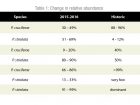
News
Understanding flea beetle control
Even though flea beetles have been around for many years, there is still a surprising amount to learn about the insects. A multi-disciplinary group of researchers at the University of Manitoba (U of MB), Agriculture and Agri-Food Canada (AAFC), and Manitoba Agriculture are working on several research products to update economic thresholds, and better understand the insects and their predators.
February 8, 2018 By Bruce Barker
 Plots showing flea beetle control with seed treatment Even though flea beetles have been around for many years
Plots showing flea beetle control with seed treatment Even though flea beetles have been around for many years“Despite being a really important pest, we know very little about important parts of the life cycle, such as the larval stage that lives below the ground, [which] can feed on plant roots,” says entomologist Alejandro Costamagna at the University of Manitoba, who presented the preliminary results of several research studies at the Manitoba Agronomist Update in Winnipeg in December 2017.
Other areas of interest are determining if there has been a shift in species of flea beetles, updating the economic threshold for foliar application, and identifying natural predators.
The two main flea beetle species are the striped (P. striolata) and crucifer (P. cruciferae). The most damaging life cycle stage is the adult that feeds on cotyledons and early leaf stages of canola. The nominal economic threshold for spraying is 25 per cent defoliation, which was established over 30 years ago.
“We hope that the new hybrids can withstand more defoliation and recover from the damage better than older varieties,” Costamagna says.
Seed treatments effective
Small plot trials were set up at sites in Manitoba, Saskatchewan and Alberta. Forty trials were conducted over three years from 2015 through 2017. A control treatment was compared to seed treatment only (fungicide and insecticide), and treatments received a foliar application of Matador insecticide at 34 mililitres per acre (ml/ac) when defoliation reached 15-20, 25 and 45 per cent (seed received fungicide treatment only). SY 4135 Roundup Ready hybrid canola was grown.
Flea beetle abundance and species composition was observed weekly and defoliation was monitored Mondays, Wednesdays and Fridays on 40 plants per plot, and plant density was also assessed. Spraying was required on 35 of the trials, and yield data was obtained in 32 of the trials.
“In some cases, the level of defoliation didn’t reach 45 per cent. We learned really quickly that we had to analyze the data based on the level of defoliation,” Costamagna says. “We also learned that even if you go every other day during the week, if you skipped the weekend, you could go from 10 per cent to 50 per cent defoliation very quickly.”
Generally, Costamagna says the preliminary results indicate that the seed treatments worked very well, and yields were usually significantly higher than the control, and often similar to a foliar spray at around 25 per cent defoliation. Yields with foliar insecticide treatments were also effective. “When spraying around 25 per cent defoliation, we didn’t seem to loose yield.”
Future analysis of data will look at plant density, flea beetle species composition and abundance, and the effect of planting dates on flea beetle damage and insecticidal control.
Shift in flea beetle species
The research also looked at whether there has been a shift in flea beetle species across the Prairies. In the mid-2000s, James Tansey, working with Lloyd Dosdall at the University of Alberta, found that neonicotinoid seed treatments provided better control of crucifer flea beetles than striped flea beetles. Very little damage for crucifer flea beetle was seen but striped flea beetle caused significantly more canola seedling damage.
“One of the concerns that this raised was that these seed treatments would not be effective if there was a shift to more striped flea beetles,” Costamagna says. “The prediction that they made in this paper was that this might result in a shift in species because the level of control is not as effective. From our data that is what seems to be going on.”
As part of Costamagna’s research, species composition was assessed over three years across the Prairie provinces, at 25 to 29 sites per year. He compared the composition to historical results in the scientific literature.
“Aside from Beaverlodge where the striped flea beetle has been dominant, there is clearly a shift in species composition to increase the proportion of striped flea beetle, and that may have something to do with the striped flea beetle’s tolerance to insecticidal seed treatment,” says Costamagna.
Natural enemies identified
Another component of the research was to identify beneficial insects that can help control flea beetles. Graduate student Thais Silva Guimaraes of the University of Manitoba set up several research trials. The first was a growth chamber trial where flea beetles and generalist predators were put in petri dishes for 72 hours. Daddy long leg spiders (Phalangium sp.) were not effective in capturing flea beetles, however several common ground beetles (Amara sp., Poecilus sp. and Pterostichus sp.) were able to significantly reduce flea beetle survival.
“The generalist ground beetle predators very quickly ate all of the flea beetles with no difference between flea beetle species. This is very encouraging,” Costamagna says.
A second experiment used caged potted plants in growth chambers. Predator ground beetles and striped or crucifer flea beetles were placed in the caged pots and flea beetle consumption was evaluated after 24 hours. The predators were able to catch and eat some of the flea beetles.
“Even if the predators didn’t eat the flea beetles, preliminary observations suggest less damage in cages with the predators and that seems to be independent of mortality. The presence of the predators seemed to make the flea beetles restless and they might not be feeding as much as they would in the absence of predators,” Costamagna says.
Another area of interest is what happens at night. Ground beetles are nocturnal, but scientists don’t know much about what flea beetles do at night. If flea beetles rest at night, ground beetles may more easily catch them.
“There are still a lot of questions we are interested in answering,” he says. The next stage of the research is to do caged studies under field conditions.
Additional work is also being conducted on using molecular methods to determine the natural enemies of flea beetles.
While the research is still being analyzed, and much more is to be done to understand flea beetle biology and predator behavior, current management practices for flea beetle control appear to be still valid. Seed treatments provide good control and spraying an insecticide if defoliation reaches 25 to 30 per cent is still the nominal economic threshold to observe.

